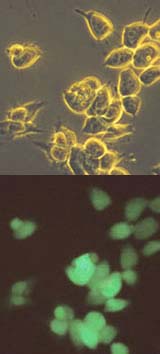Stem-cell powers challenged

Transfer of green dye suggests adult stem cells and ES cells fuse. <br>© Nature <br>
Fusion may explain adult stem-cell morphing.
The hyped ability of adult stem cells to sprout replacement tissue types is being called into question. They may instead be fusing with existing cells, say two new reports, creating genetically mixed-up tissues with unknown health effects.
Recent studies have shown that adult stem cells transplanted from one tissue, such as blood, can spawn the cell types of another, such as nerves. The findings have stirred intense interest in stem cells’ medical potential to repair damaged or diseased tissues.
Now researchers have evidence that, rather than switching fates, adult stem cells may be fusing with those in existing tissues1,2. The resulting cells carry double the normal amount of DNA, and may be sickly.
The findings are a reality check for those hoping to use adult stem cells for clinical purposes. “The fusion issue is an important one,” agrees stem-cell researcher Diane Krause of Yale University. She and others must now investigate whether fusion can explain their results, she says, and these experiments are under way.
Fate or fusion
When certain adult stem cells are injected into mice, their descendants have been found in muscle, liver, brain and heart. Like stem cells from embryos (ES cells), adult stem cells are thought to be able to give rise to many other cell types in the body.
Some researchers remain sceptical about this, as it challenges a long-held notion that adult stem cells are committed to producing only one class of cell. “There’s something unprecedented going on,” says Austin Smith of the University of Edinburgh, UK.
Smith and Naohiro Terada of the University of Florida in Gainesville, looked for an alternative explanation. They grew adult stem cells from bone marrow and brain in the same dishes as ES cells. Both types fused spontaneously into hybrid cells. These acquired the properties of ES cells and produced muscle, nerve and other cell types.
Fusion occurs rarely – only once for every 10,000-100,000 cells. But the researchers think that transplanted stem cells fusing with cells around the body could explain some of the previous results. “It is quite possible that such fusion events have been previously misinterpreted,” agrees Fred Gage, who works on nerve stem cells at the Salk Insitute in La Jolla, California.
However, Smith and Terada have only demonstrated fusion under very specific culture conditions; their results may not prove relevant to other situations, Krause warns.
Cell safety checks
How stem cells produce new tissue is important. Offspring formed by fusion may carry twice the normal number of chromosomes. This could make the cells genetically abnormal, precluding their medical use. Researchers agree that more rigorous criteria are needed to establish how new cells form from stem cells, and whether they function normally.
Previous transplantation experiments have not made these checks. Generally, researchers identify new cells using a fluorescent protein carried only by the original donor cell and inherited by its offspring. If cells fuse, this marker is still carried into the resulting hybrid. Only by checking for genes from the recipient animal can fusion be ruled out.
Terada and Smith concede that some stem cells may genuinely revert to an earlier stage of development or switch fates. “I’m not saying it never occurs,” says Smith. Ultimately, they hope to direct transplanted stem cells to a damaged site and turn them into the tissue that is needed. Again, the mechanism by which this occurs must first be worked out.
References
- Terada, N. et al. Bone marrow cells adopt phenotype of other cells by spontaneous cell fusion. Nature, Advanced online publication DOI: nature730 , (2002).
- Ying, Q-L., Nichols, J., Evans, E. & Smith, A.G. Changing potency by spontaneous fusion. Nature, Advanced online publication DOI: nature729, (2002).
Media Contact
All latest news from the category: Life Sciences and Chemistry
Articles and reports from the Life Sciences and chemistry area deal with applied and basic research into modern biology, chemistry and human medicine.
Valuable information can be found on a range of life sciences fields including bacteriology, biochemistry, bionics, bioinformatics, biophysics, biotechnology, genetics, geobotany, human biology, marine biology, microbiology, molecular biology, cellular biology, zoology, bioinorganic chemistry, microchemistry and environmental chemistry.
Newest articles

Measuring defects to better understand quantum systems
Quantum defects have the potential to act as ultra-sensitive sensors that could offer new kinds of navigation or biological sensor technology. One type of these defect systems, nitrogen vacancy (NV)…

Photonic computing harnesses electromagnetic waves
New photonic computing method uses electromagnetic waves to solve partial differential equations rapidly. In the fields of physics, mathematics, and engineering, partial differential equations (PDEs) are essential for modeling various…

Controlling prosthetic hands more precisely by the power of thought
Neuroscientists show how fine motor skills of neural prostheses can be improved. Researchers at the German Primate Center – Leibniz Institute for Primate Research in Göttingen have developed a novel…



